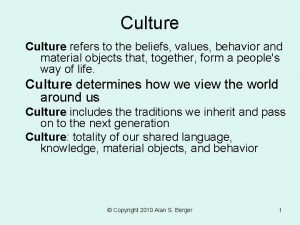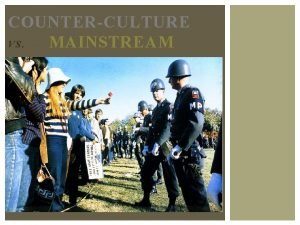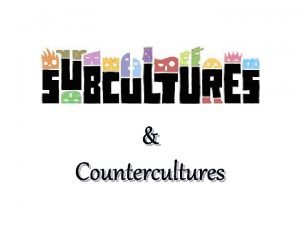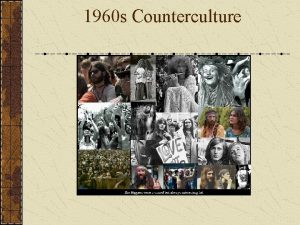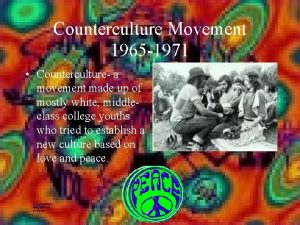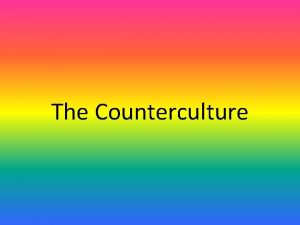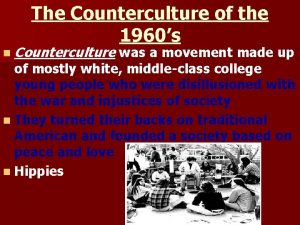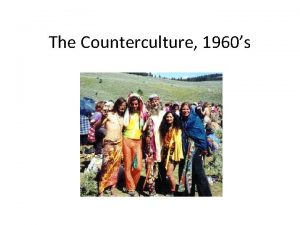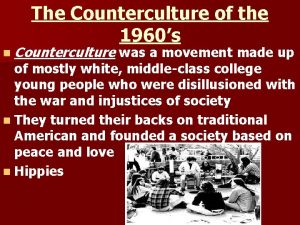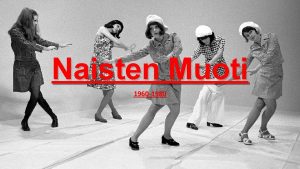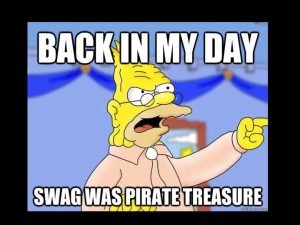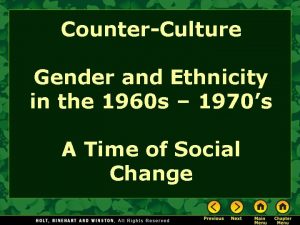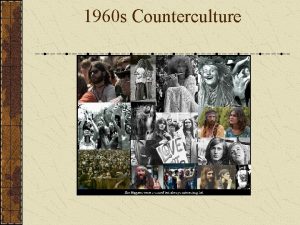1960 s Culture Page 71 Goal 11 Counterculture















- Slides: 15

1960 s Culture Page 71 Goal 11

Counterculture • 1960 s youth who wanted society based on peace, love, freedom -non-conformists • Disillusioned with mainstream American life -”Tune in, turn on, drop out” Timothy Leary • Left school, work, home to create ideal community - California -hippies rock music, radical appearance, drug use, communal living, eastern religions -counterculture turned violent and failed to cope with reality of surviving - No responsibility -many died of drug overdose or became welfare recipients “It was like paradise there. Everybody was in love with life and in love with their fellow human beings to the point where they were just sharing in incredible ways with everybody. Taking people in off the street and letting them stay in their homes…You could walk down almost any street in Haight-Ashbury, where I was living, and someone would smile at you and just go, ‘Hey, it’s beautiful, isn’t it? ’”

The hippie era, sometimes known as the Age of Aquarius, was marked by rock ‘n’ roll music, outrageous clothing, sexual license, and illegal drugs—in particular, marijuana and a new hallucinogenic drug called LSD, or acid. Timothy Leary, an early experimenter with the drug, promoted the use of LSD as a “mind-expanding” aid for self-awareness. Hippies also turned to Eastern religions such as Zen Buddhism, which professed that one could attain enlightenment through meditation rather than the reading of scriptures.

Changing Culture -hippie generation cultural influence -pop art Andy Warhol • Bright, simple, commercial images -fashion trends • Tie-dyed shirts, ragged jeans, military garments, love beads -rock music British Invasion (Beatles) form of protest Pop artists, led by Andy Warhol, attempted to bring art into the mainstream. Pop art was characterized by bright, simple, commercial-looking images often depicting everyday life. These images were repeated to look mass-produced and impersonal, a criticism of the times, implying that individualism had been lost to the “cookie-cutter” lifestyle. Woodstock, 1969 - 3 -day music and art festival in NY: drugs, sex, generally peaceful -sexual revolution -casual and permissive attitudes -conservative backlash • People want a return to a calm, moral America - elect Nixon

The British Invasion


One example of rock ‘n’ roll’s popularity occurred in August of 1969 on a farm in upstate New York. More than 400, 000 showed up for a free music festival called “Woodstock Music and Art Fair. ” For three days, the most popular bands and musicians performed, including Jimi Hendrix, Janis Joplin, Joe Cocker, Joan Baez, the Grateful Dead, and Jefferson Airplane. Despite the huge crowd, Woodstock was peaceful and well-organized, though very open and “social” to its visitors.

The Woodstock Generation

People try to put us d-down (Talkin' 'bout my generation) Just because we get around (Talkin' 'bout my generation) Things they do look awful c-c-cold (Talkin' 'bout my generation) I hope I die before I get old (Talkin' 'bout my generation) This is my generation, baby Why don't you all f-fade away (Talkin' 'bout my generation) And don't try to dig what we all s-s-say (Talkin' 'bout my generation) I'm not trying to cause a big s-s-sensation (Talkin' 'bout my generation) I'm just talkin' 'bout my g-g-g-generation (Talkin' 'bout my generation) This is my generation, baby Why don't you all f-fade away (Talkin' 'bout my generation) And don't try to d-dig what we all s-s-say (Talkin' 'bout my generation) I'm not trying to cause a b-big s-s-sensation (Talkin' 'bout my generation) I'm just talkin' 'bout my g-g-generation (Talkin' 'bout my generation) This is my generation, baby People try to put us d-down (Talkin' 'bout my generation) Just because we g-g-get around (Talkin' 'bout my generation) Things they do look awful c-c-cold (Talkin' 'bout my generation) Yeah, I hope I die before I get old (Talkin' 'bout my generation) This is my generation, baby

Women’s Movement -feminism belief in equality with men • Political, social, economic equality -more women in the workforce • Kept out of men’s jobs, paid less • “Glass ceiling” -Betty Freidan “Feminine Mystique”, 1963 book called on women to examine their lives for true happiness sparked the women’s movement for millions -Women’s Liberation • Want equality of opportunity (sparked by Civil Rights) “It makes you very sensitive—raw, even, this consciousness. Everything, from the verbal assault on the street, to a ‘well-meant’ sexist joke your husband tells, to the lower pay you get at work (for doing the same job a man would be paid more for), to TV commercials, to rock-song lyrics, to the pink or blue blanket they put on your infant in the hospital nursery, to speeches by male ‘revolutionaries’ that reek of male supremacy—everything seems to barrage your aching brain…You begin to see how allpervasive a thing is sexism. ”

Women Fight for Rights -NOW established • National Organization for Women fights for daycare facilities and an end to job discrimination -Equal Employment Opportunity Commission • End workplace discrimination, not enforced -Gloria Steinem Ms. Magazine • Created a magazine to show current issues from a feminist perspective -Roe v. Wade, 1973 made abortion legal -ERA (Equal Rights Amendment) • Did not get passed because of conservative anti-feminist movement

In what seemed at first to be another triumph for the women’s movement, Congress passed the Equal Rights Amendment (ERA) in 1972. The amendment then needed ratification by 38 states to become part of the Constitution. First introduced to Congress in 1923, the ERA would guarantee that both men and women would enjoy the same rights and protections under the law. It was, many supporters said, a matter of “simple justice. ” The amendment scared many people, and a Stop-ERA campaign was launched in 1972. Conservative Phyllis Schlafly, along with conservative religious groups, political organizations, and many anti-feminists, felt that the ERA would lead to “a parade of horribles, ” such as the drafting of women, the end of laws protecting homemakers, the end of a husband’s responsibility to provide for his family, and same-sex marriages. Schlafly said that radical feminists “hate men, marriage, and children” and were oppressed “only in their distorted minds. ”

Latino Rights -great increase in Latino populations • Americans of Latin descent -many lived in segregated barrios • Spanish-speaking neighborhoods -faced discrimination and poverty • No benefits, minimum wage • Many families below poverty line -Cesar Chavez United Farm Workers • Latino union that gained higher wages and benefits -fight for better education and political power • Want equal opportunities, bilingual education, and cultural respect “Wherever I went to speak…I told them about…how we had no benefits, no minimum wage, nothing out in the fields—no restrooms, nothing…I said, ‘Well! Do you think we should be putting up with this in this modern age? We can stand up! We can talk back!. . . This country is very rich, and we want a share of the money those growers make [off] our sweat and our work by exploiting us and our children!”

Native Americans -US policy toward Indians had always been a failure -American Indian Movement wanted faster changes and reforms of Indian policy protests of broken treaties • Wanted restoration of Native land respect for culture “My first encounter with AIM was at a pow-wow held in 1971…One man, a Chippewa, stood up and made a speech. I have never heard anybody talk like that. He spoke about genocide and sovereignty, about tribal leaders selling out…He had himself wrapped up in an upside-down American flag, telling us that every star in this flag represented a state stolen from the Indians…Some people wept. ” -Indian groups won back some tribal lands and have been given greater control over Indian affairs • $25, 000 at 18

Let’s Twist!!
 1950s conformity and counterculture
1950s conformity and counterculture Beliefs values behavior and material objects
Beliefs values behavior and material objects Multiculturalism examples
Multiculturalism examples Brethren defintion
Brethren defintion What is a subculture
What is a subculture Mainstream vs counterculture
Mainstream vs counterculture Examples of countercultures
Examples of countercultures The members of the counterculture movement were mostly
The members of the counterculture movement were mostly Counterculture in the philippines
Counterculture in the philippines Apa format running head
Apa format running head Describe lawn culture and surface plating
Describe lawn culture and surface plating Uses of selenite f broth
Uses of selenite f broth Homework due today
Homework due today Batch culture vs continuous culture
Batch culture vs continuous culture Characteristics of quality culture
Characteristics of quality culture Folk culture and popular culture venn diagram
Folk culture and popular culture venn diagram

